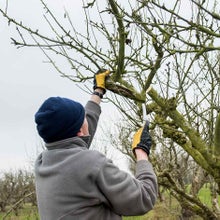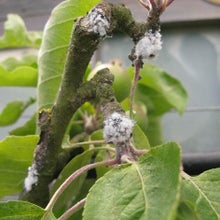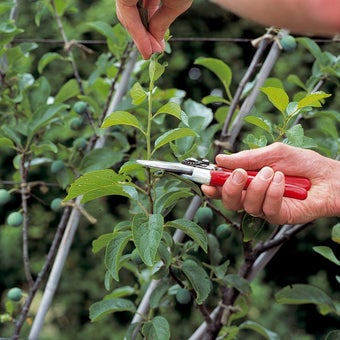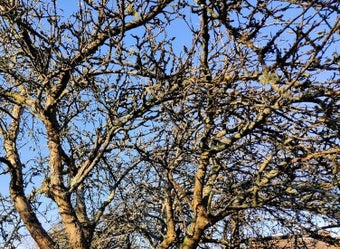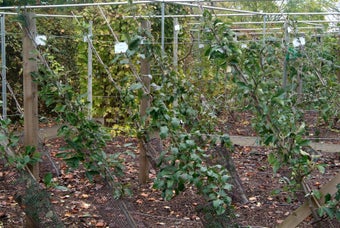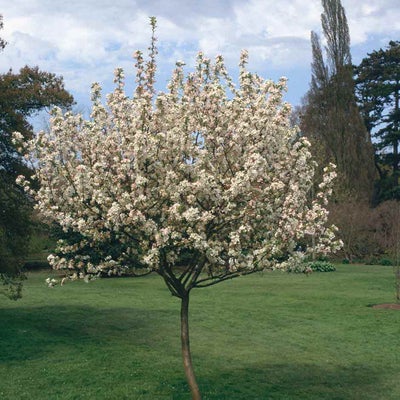
Quick facts
Suitable for - Apples and pears grown as bush or standard trees
Timing - November to early March
Difficulty - Moderate
Before you start
The aim of winter pruning is to maintain anopen-centred, goblet-shaped crown with well-spaced main branches radiating from the trunk. This allows light to reach all parts of the tree and ensures good air flow through the canopy, resulting in better quality crops and fewer pests and diseases.
It should be done while the tree is , after leaf fall and before it starts growing again ( burst), which is usually between November and early March.
If you’re new to fruit pruning or aren’t feeling very confident, first take a look at pruning made easy.
Which trees to winter prune
Winter pruning is for established apples and pears trained as bush trees (with a crown on a short trunk) or standard and half-standard trees (with a taller trunk), usually starting four or five years after planting.
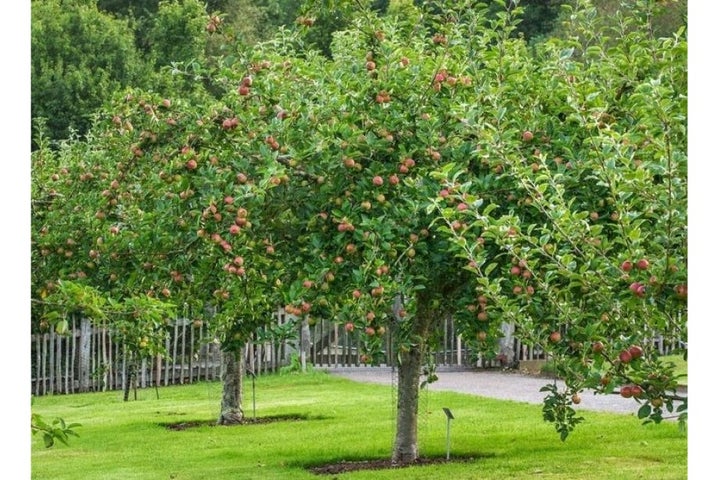
For more recently planted trees, follow our advice on pruning young apples and pears. For space-saving restricted shapes, such as espaliers, cordons, fans and pyramids, use summer pruning.
Use the same method for all types
Apple and pear cultivars can be divided into three groups according to where the fruit bud is produced and the fruit carried: spur-bearers, tip-bearers and partial tip-bearers.
Traditionally the pruning advice for spur-bearing trees was different to the advice for tip-bearing and partial tip-bearing trees. But the current pruning approach is more relaxed and very similar for all three. We no longer recommend routine rigorous shortening of all young growth on spur-bearing trees. However, understanding the fruiting habit of your tree can help you prune more effectively to ensure a good crop.
How much to remove
This depends on the tree’s vigour and needs a bit of judgement. Routine winter pruning should remove about 10–20 per cent of the canopy. Pruning too hard will result in a mass of vigorous, upright growth known as watershoots. Take care not to overprune tip-bearers and partial tip-bearers, as this may remove most of the potentially fruiting wood.
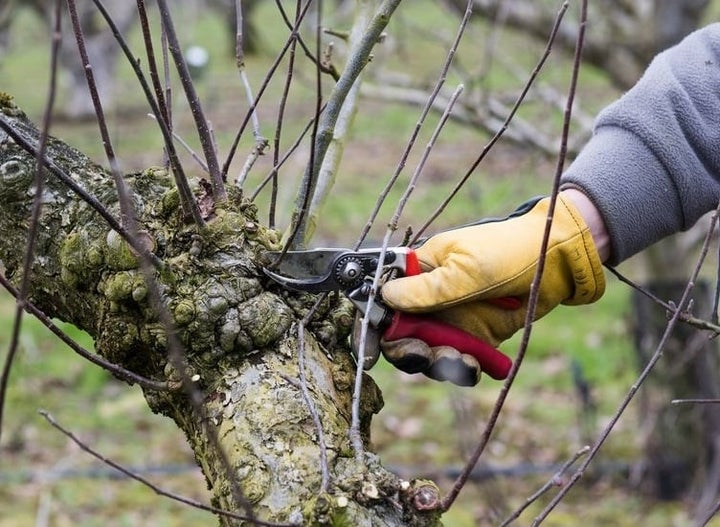
Tools you’ll need
Secateurs, loppers and pruning saw – these are each suited to different diameters of shoots and branches. Make sure the blades are sharp – blunt tools lead to tatty pruning cuts and make the work harder
Sturdy ladder – consider investing in a tripod (Japanese-style) ladder that is more stable. Versions with adjustable legs are suitable for sloping ground
Eye protection to avoid injury from twiggy branches or sawdust
Gloves
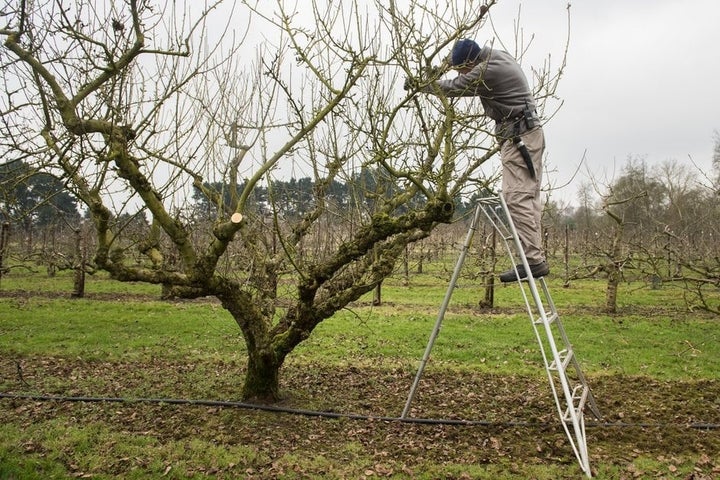
How to winter prune apples and pears
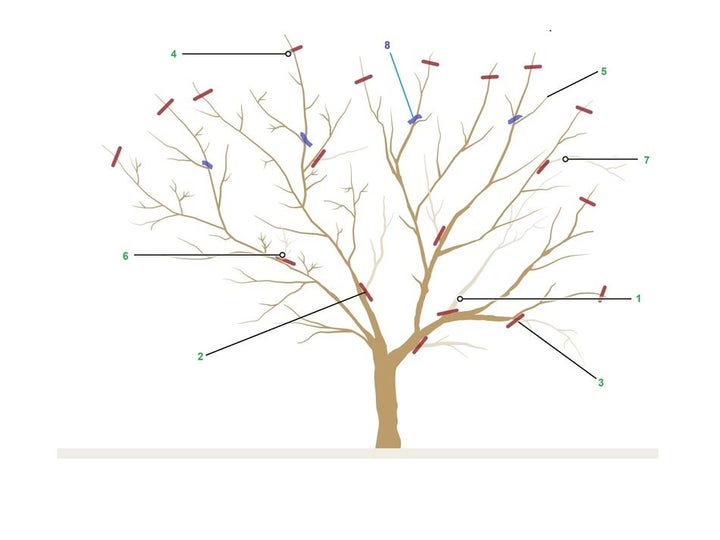
Start by removing any dead, diseased and damaged shoots and branches, then carry out the following steps:
- Remove crossing shoots that are rubbing together. Keep the better placed, outward-facing one, unless it’s badly damaged
- Prune out strong shoots growing towards the centre. You can leave weaker shoots (up to 20cm/8in long) unpruned
- Look for any downward-growing branches low on the tree that receive little light and could cause an obstruction. Prune to a more upward-growing branch or back to the main trunk
- Shorten the previous year’s growth on each of the main branches by a quarter to one-third, cutting just above an outward-facing . This will encourage branching and the formation of fruiting spurs (stubby shoots with fruit )
- Leave young side-shoots (laterals) unpruned, so they can develop fruit buds in the second year. Only remove them if they’re crossing or too crowded – closer than 10–15cm (4–6in) apart at the base
- For spur-bearing trees On older trees, remove or thin out spurs (short stubby shoots with fruit buds) that have become overcrowded, aiming to space them 10–15cm (4-6in) apart along the branches
- For tip-bearing or partial tip-bearing trees Such as ‘Blenheim Orange’, ‘Bramley's Seedling’, 'Cornish Gilliflower', ‘Discovery’, ‘Lord Lambourne’ and ‘Worcester Pearmain’. Reduce the length of older, long, fruited branches by up to a quarter to a strong younger side-shoot positioned closer to the main trunk. This will prevent the branches becoming too long
- For larger, more mature trees Reduce excess height or overcrowding by shortening larger branches by up to a third. Prune to a strong outward- and upward-facing side-branch that’s at least one-third of the diameter of the branch being pruned
How to prune safely
For advice on safety when pruning and how to remove large branches, see our guide to pruning trees.
Pruning large and overly vigorous trees
Pruning overly vigorous trees
If your tree is too vigorous, sending out an excessive amount of growth each year despite fairly light pruning, consider also pruning in summer. Summer pruning depletes the tree’s resources and helps to reduce vigour.
Note: this is done in addition to winter pruning, so it’s a little different from the summer pruning carried out on restricted fruit trees, such as cordons and espaliers.
- Spread this pruning between mid-August to mid-September, pruning shoots that stopped growing (ie formed a terminal ) first
- Look for side-shoots (laterals) where the current season’s growth is longer than 30cm (1ft) and reduce it to 15cm (6in). This will encourage fruit s to form. The current season’s growth is usually the leafy end-part of the shoot, easily bendable and with paler
- Only prune the more vigorous side-shoots, not all of them
- Then in winter you’ll need to thin out some of the side-shoots if the growth becomes crowded
Pruning trees that are too big
Even trees that are regularly winter pruned are likely to become gradually larger, making picking more difficult and potentially outgrowing the available space. Ultimately, older trees may require renovation.
To avoid renovation, when the tree has reached an optimum size for the rootstock that it’s grafted on, regulated pruning can be used instead of the process described here. This will control the size of the tree without reducing its fruiting.

Problem solving
When pruning, you may notice signs of apple canker on the stems – affected growth should be cut out where possible.
Lichens and other growths are also more noticeable in winter, but these do no harm, although if they’re present on shoot tips they can indicate poor vigour.
The flowers and young developing fruit can suffer late frost damage in spring, which may affect fruit production.
Be aware of biennial bearing, when a tree crops unevenly, producing a bumper crop one year, followed a poor crop the next.


